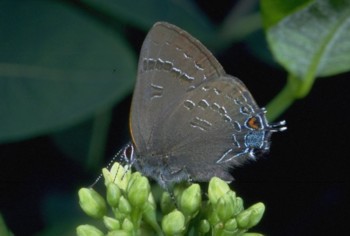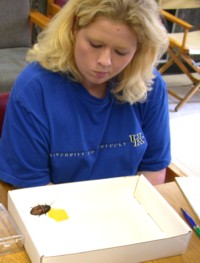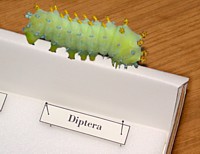

 |
|
Contents | |
|
2002 Identifying With Insects Workshop
|
|
|
2002 Identifying With Insects Workshop
|
| This summer, Kentucky Science Teachers and Extension Agents had a chance to get up-close and personal with
arthropods at the 2002 Identifying With Insects Workshop. The workshop was
held at the Maywoods Environmental Laboratory near Berea, Kentucky, a fantastic place to experience insects in a
variety of habitats. During the two-day workshop, attendees got tips on how to use insects for inquiry-based classroom projects. In particular, participants designed and tested several different experiments using roly-polies and giant hissing cockroaches! Giant cockroaches? Who would've thought learning about bugs could be this much fun? |
 4H Agent Miranda Shearer questions the cheese preference of her test cockroach. |
 A Cercopia Moth larvae wants hands-on entomological experience, too. |
Participants also had the chance to make an insect collection, which is probably the best way to learn the principals of insect identification. It's also fun: several participants at the workshop actually
collected more insects than we asked them to. How often do students do more than you ask them to? We're planning more workshops
in the coming months. If you would like more information about future workshops, see below for contact information! |
|
Activity: Bug Music |
Singin' ain't just for us person-type-folks. Insects enjoy hollerin' a tune every now and then, too. If'n you've ever heard crickets on a summer night, you know what we mean. But did you ever try figurin' out why insects like to make such a dag-blamed racket? As you may know, many kinds of insects make noises during courtship. It's a big world for bugs, and sound helps them find each other. But insects don't just use sound for mating. They use sound to communicate all kinds of information. An important example: many insects can produce unique sounds that they use like a code to recognize members of the same species. This is especially useful for social insects (like termites) that live and work together. |
|
|
If you put on your thinkin' cowboy hat, you'll see that this is an easy principal to demonstrate for students. All you need is a few black plastic 35mm film canisters (or other small, opaque containers). Then, depending on how many students you have in class, fill the canisters with items that will make a distinct noise when the canisters are shaken. Don't make each canister sound the same, instead, make small groups of the canisters, and give each group of canisters a unique sound. Make enough canisters so that each student gets one. For example, if you have 20 students in class, make 20 canisters. Fill 4 with BB's, 4 with paper clips, 4 with gravel, and 4 with pennies. Make sure to secure the lids so that the students can't look inside. Then randomly give out the canisters and instruct the students to find the other members of their "species" by walking around and listening to everyone's canisters when they are played "maraca-style." In a few minutes they will all find each other. Depending on the age of your students, you can make the exercise easier or harder by making the canisters that correspond with each "species" sound more or less alike (this will take some experimenting!). Or, for an even more interesting activity, figure out a way to incorporate rhythms into the codes- the big challenge there will be teaching the rhythms to individual students without giving away which group is which. And the more students, the more fun the exercise is, so be sure to invite neighboring classrooms! |
|
Did
You Know? | |
| |
|
Book
Review | |||||||
|
|
Upcoming Events |
| The Entomology Department will be present with displays, insects, and
information at the following events and locations during Fall 2002:
|
|
Wee
Beasties Mailing List | |
| |
|
Contact Information |
| If you have ideas, experiences, or information that you would like to
share or would like information about educational resources available
through the University of Kentucky, Department of Entomology, write,
phone, or email:
Blake Newton View and print Wee Beasties in the Adobe Acrobat (tm) PDF format. The Adobe Acrobat (tm) PDF format allows you to download, view, search, and print, while maintaining the original printed look of the document. You will need the (free) Adobe Acrobat Reader plug-in to read PDF documents.
Black and white images used with permission from http://www.arttoday.com/ Hairstreak, honeybee, and bee fly photos courtesy of R. Bessin, Department of Entomology, University of Kentucky Insect Workshop photos courtesy of B. Newton, Department of Entomology, University of Kentucky Country & Western Bug cartoon courtesy Chris Ware, 2000
Educational Programs of the Cooperative Extension
Service serve all people regardless of race, color, age, sex, religion,
disability, or national origin. UNIVERSITY OF KENTUCKY, KENTUCKY STATE UNIVERSITY, DEPARTMENT OF AGRICULTURE AND KENTUCKY COUNTIES COOPERATING. |